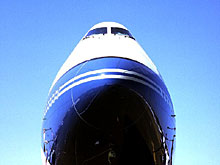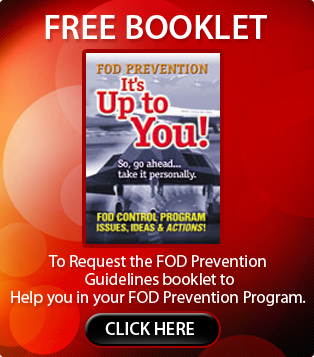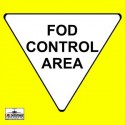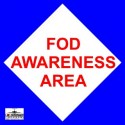Foreign Object Damage happens when ANY object or substance is introduced to a system and causes that particular system to malfunction or be degraded. This debris can take many forms, big or small, especially when an object is left in the nooks and crannies of an airplane during assembly or maintenance. Outside of the aircraft, objects and chemicals used by personnel can damage airplane skins and cause FOD.
 FOD can be alive too, such as birds hitting the airplane while both are in flight, or birds ingested during engine testing. A few years ago, a bird’s nest was found on the fixed leading edge of a 767 awaiting delivery on Boeing’s Everett flight line. When the technicians removed the grass and twig structure, they found all kinds of other materials in the nest – such as staples, rubber bands, paper clips, paper and safety wire. This shows how easy FOD can happen in the manufacturing environment.
FOD can be alive too, such as birds hitting the airplane while both are in flight, or birds ingested during engine testing. A few years ago, a bird’s nest was found on the fixed leading edge of a 767 awaiting delivery on Boeing’s Everett flight line. When the technicians removed the grass and twig structure, they found all kinds of other materials in the nest – such as staples, rubber bands, paper clips, paper and safety wire. This shows how easy FOD can happen in the manufacturing environment.
According to Dan Swanburg, FOD Program Manager for Boeing Commercial Airplane Group in Everett, Washington, the focus with FOD should not be only on money because it’s extremely important in the airline industry to realize that reputations are at stake. It’s hard to estimate the amount of dollars in damage FOD causes. When an airplane has just left and is not due back for maintenance until a couple thousand hours, and then returns with FOD damage after only 100 hours, how do you estimate the amount of money lost? Sometimes you have to go with your best estimates, but it boils down to one thing – FOD causes money to be lost!
Setting up a FOD Program consists of a few steps:
1) Define the problem for management.
2) Look at other companies FOD Prevention Programs. The military does an excellent job at preventing FOD.
3) Educate company leadership – the program developers need to:
- Show the problems once they have been defined.
- Prepare a cost analysis – figure out what FOD is costing your company.
- Funding – let the leaders know that a proper FOD Prevention Program will cost only a percentage of what the actual FOD losses are.
- Target a return on investment based on realistic goals.
- Top-level management support is extremely important. When employees see management taking an active role in FOD prevention, it becomes more important to them also.
- Setting up processes and procedures. The program should be tailored to the specific area. Be sure to look at the guidelines (NAS 412) appropriate for your facility, and then tailor the program to your facility.
- It’s important for someone to take charge of the FOD Prevention Program, maintain the documents and work with the team.
- Be sure to gain full employee involvement. FOD prevention has to be supported from the top down. Problems should be presented to employee teams because the people that work in manufacturing areas are smarter than those who don’t. Employees should have the opportunity to say how they would improve things based on their experiences.
- Education and awareness are important. Annual training is essential. New people should be trained in FOD awareness right away.
- Give incentives for your employees.
Once your FOD Prevention Program is set up, you need to maintain your program with the following steps:
1) Follow the FOD procedures for your area and have a “clean as you go” ethic. Clean after each job or operation to ensure that the area is FOD free.
2) Report all lost tools or items – anything that is missing at the end of the day. Make sure your people are praised for coming forward to report missing items – if your employees feel threatened, they won’t come forward.
3) Be accountable for all tools used – whatever is taken on to the aircraft must come back and should be verified before the area is closed. A tool program could be implemented by developing a “shadowbox” arrangement for their toolbox. A contoured space exists for every tool to help ensure accountability. Some programs go even further – when an employee begins their shift, they acquire a ring of tool checks for the tools needed that day. When a tool is removed from the box, a tool check is placed in the open space created. At the end of the day, checks and tools should balance – no empty spaces in the tool drawer. Everything should balance.
4) Secure loose items prior to and during the entry onto an aircraft. Make sure items in employee pockets (pencils, pens, etc.) are removed so they don’t become FOD.
5) Perform daily visual inspections. FOD walks (inspections of the areas around the flight line and in the hangar) should be done by management and technicians, together. This shows employees that management is serious about FOD prevention and that it is everyone’s responsibility.
6) Make sure employees are involved with management to eliminate FOD.
7) Develop constant awareness by keeping the message alive through posters, newsletters, incentive programs, etc.
Prevent and rectify FOD problems:
1) Establish metrics – procedures to track things, keeping data and measurements. This could include self-audits, and maybe an audit team that looks at an operation to check for FOD. If incidents aren’t tracked, the operation could end up with a collection of events that get treated separately, but could be FOD related trends.
2) Track escapements – anything that escapes your area and winds up down the line or elsewhere.
3) Quality metrics – whenever rejection slips or picks are written, look for trends in those articles to see if they are FOD related.
4) Rely on your FOD team to rectify situations – teams create a database system to spot trends that will help in finding solutions, as well as to communicate to others some of their findings and best practices.
 Finally, we need to change the FOD culture. The military has always installed in their people that FOD is unacceptable – the private sector still needs to be educated and come up to the level of the military.
Finally, we need to change the FOD culture. The military has always installed in their people that FOD is unacceptable – the private sector still needs to be educated and come up to the level of the military.
The complete article for Setting up a FOD Program for the Maintenance Facility can be found at www.amtonline.com — click on the “Article Archives” function – then type in “Foreign Object Damage” in the General Search box.



